Product marketing can seem like a catch-all for the many various skills, tasks, and activities that help people discover and love a product.
Because of this, product marketing can have few bounds.
It can feel loose yet vital. Abstract yet essential. Fuzzy yet powerful.
And because of this juxtaposition, there’s a risk that you won’t get the full impact of proper product marketing if you don’t have things figured out for your team. This is a trap that we’ve fallen into before at Buffer as our teams have evolved. We’ve reorganized as we’ve grown, and we’d love to share the latest way we’re looking to optimize our product marketing setup so that our product can grow.
Have you learned a thing or two about product marketing for your brand? It’d be great to hear from you in the comments or on Twitter.
3 Stages of Product Marketing Teams at Buffer
1. Everyone does product marketing (team size: 0-25 people)
For anyone who’s been part of a small, nimble team, you’re probably very familiar with the multiplicitous nature of the work. You wear a lot of hats. You do whatever it takes to get the job done.
This is how we approached product marketing in the early days of Buffer.
No one had the title of Product Marketer.
We had a three-person marketing team:
- One of our two co-founders
- A content marketing manager
- A content writer
No one in this group was a craftsperson whose primary focus was product marketing. We were all generalist who took turns with the different aspects of the role. We approached product marketing on an as-needed, ad hoc basis.
For instance, our marketing website was fully managed by our product team. Typically, the website is an area where the marketing team can make a big impact with positioning and A/B testing and conversion optimization. Instead, in the early days at Buffer, the product team graciously lent a hand with all those tasks.

2. One product marketer for everything (team size: 26-75 people)
As the product and team grew, we realized that there was enough work to do — more than enough work, in fact — to have a marketer working full time on product.
So we carved out a full-time role on the marketing team for a product marketer. Here is what we came up with for a job description at the time:
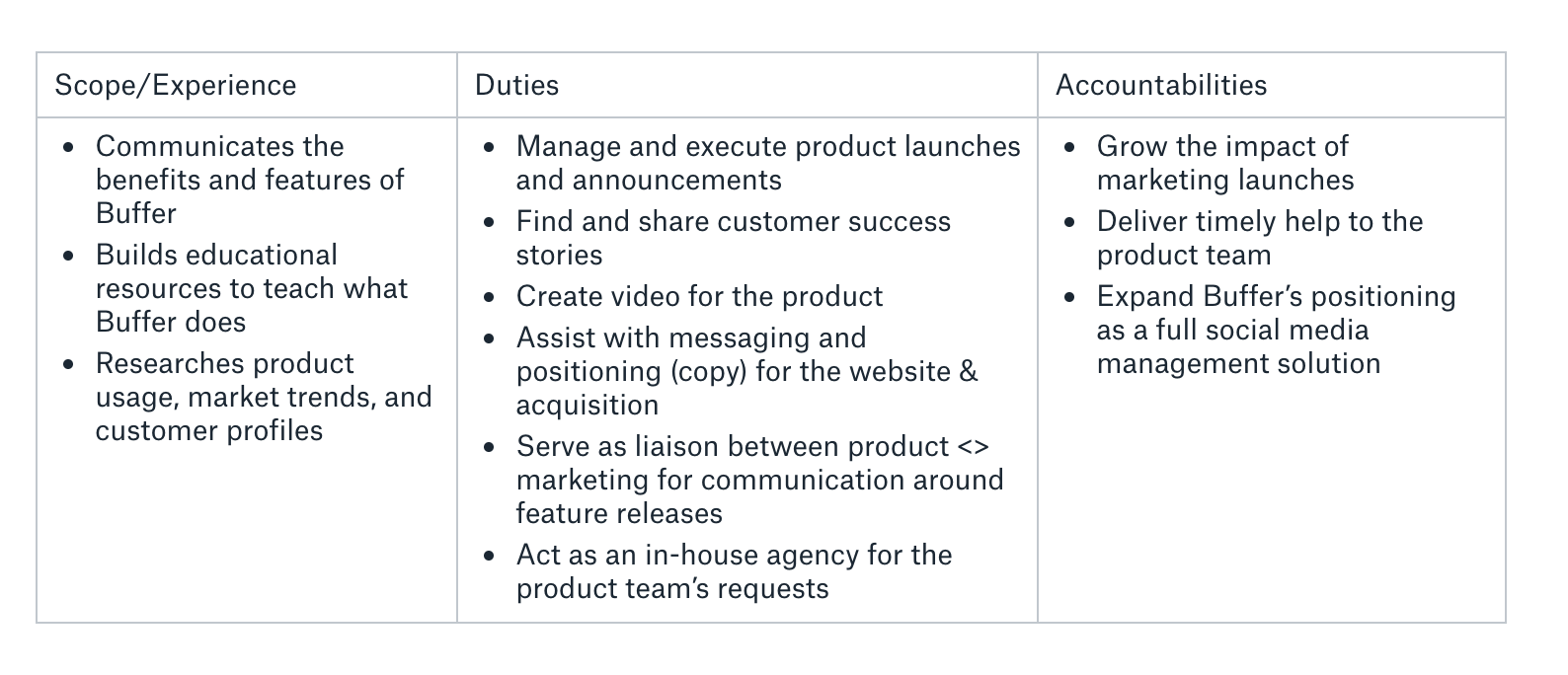
(See that bullet point about “act as an in-house agency”? I’ll share more on that in a minute.)
The breaking point for us, when we realized that we could no longer do product marketing as a group, was the growing scope of lifecycle emails and product launches. Now, there are so many other aspects to product marketing, too; but we found that our original, ad hoc model broke when it came to the project management for these very big, very important projects.
Pretty soon, though, we realized just how long our product marketing wish list had grown. We were eager to have someone who could:
- Work on product positioning
- Build out a resource library of videos
- Liaise between product and marketing
The formal responsibilities ended up looking like this:
Communication / Education / Research
Communication
- Refine product positioning based on customer research and product vision.
- Refine product messaging across all stages of the customer journey.
- Manage and execute product launches and announcements.
- Drive awareness of the product in the market.
Education
- Develop assets that showcase Buffer’s suite of products.
- Act as a product resource for customers and teammates.
Research
- Use data to uncover opportunities to improve product adoption.
- Develop a deep knowledge of our customers to help inform product messaging and feature prioritization.
- Maintain regular competitive analysis documentation for internal and external usage.
A quick experiment with product marketing as an in-house agency
Toward the end of this phase of product marketing, we began to question where this role should exist in our org chart. Should this person be part of marketing? Should this person be part of product? We didn’t feel quite ready to make the leap to product, so we tried an interim solution: treating product marketing as an in-house agency to serve any need for the product team.
If the product team needed new emails written, the product marketer would write them. If the product team needed help with a go-to-market strategy for a new product release, the product marketer would jump in.
Ultimately, this experiment proved short-lived. The tricky bit was that an agency model removes the ownership from the product marketer. They never truly feel connected to the work.
3. One product marketer per product team (team size: 80+ people)
We’ve undergone a lot of exciting changes at Buffer over the past two years. A couple of the biggest changes are:
- We now have three products: Publish (the original Buffer), Reply, and Analyze
- Our team is now 80+ people
Because of these two factors, we felt it was time to rethink our product marketing setup. Specifically, we wanted to create an environment where our product marketers felt directly connected to the success of the product.
In many ways, we wanted to create the feeling of that very small team again, where a marketer could have an outsize impact by being directly involved with whatever product initiatives were happening now.
The solution we came up with: We have a dedicated marketer who works side-by-side with each product manager.
We intend for these two to be partners — co-founders, if you will.
The product manager (PM) has a set of goals that he and the product marketer work on together.
We have similarly dedicated roles within our product teams. Each team has a dedicated designer, and we’ve explored a dedicated data analyst and researcher as well.
This diagram shows how our product teams look today, as well as how the product marketers remain connected to the marketing team at large.
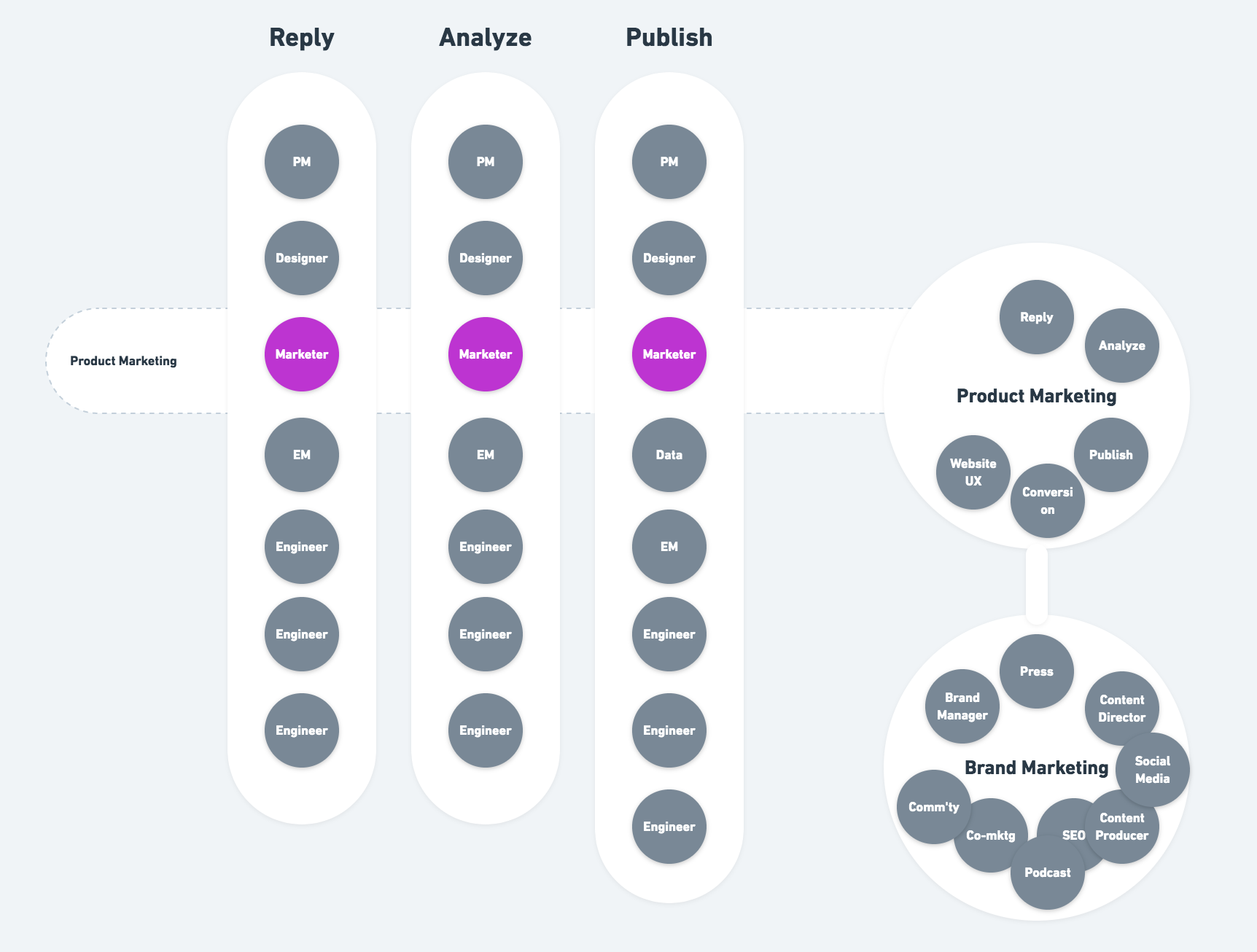
We’ve taken a lot of inspiration to the Spotify Model for organizing their teams. In a lot of ways, our setup borrows from the “Chapter” idea of the Spotify Model.
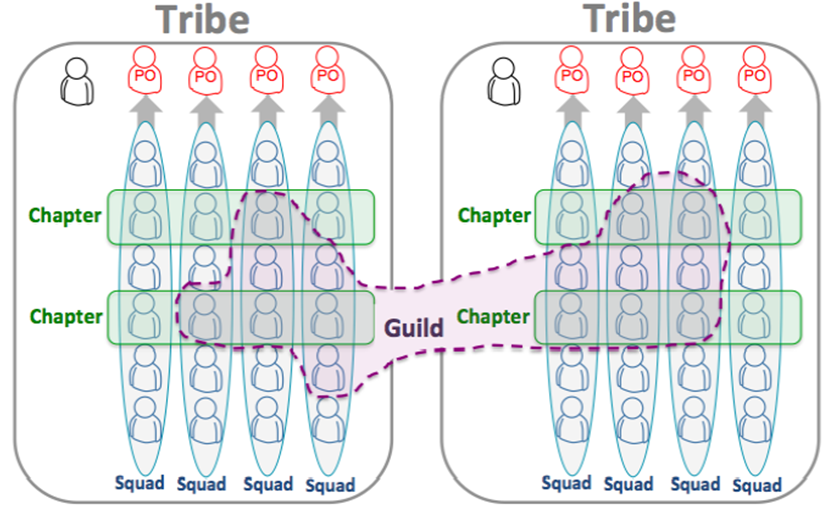
The product marketing shift has led to some changes on our marketing team proper, as well.
Since we have three products to market, we’ve shifted our resources so that we can have dedicated marketers on each. At the moment, we have one person doing marketing for our younger products, Reply and Analyze, but we imagine this will change as those products evolve.
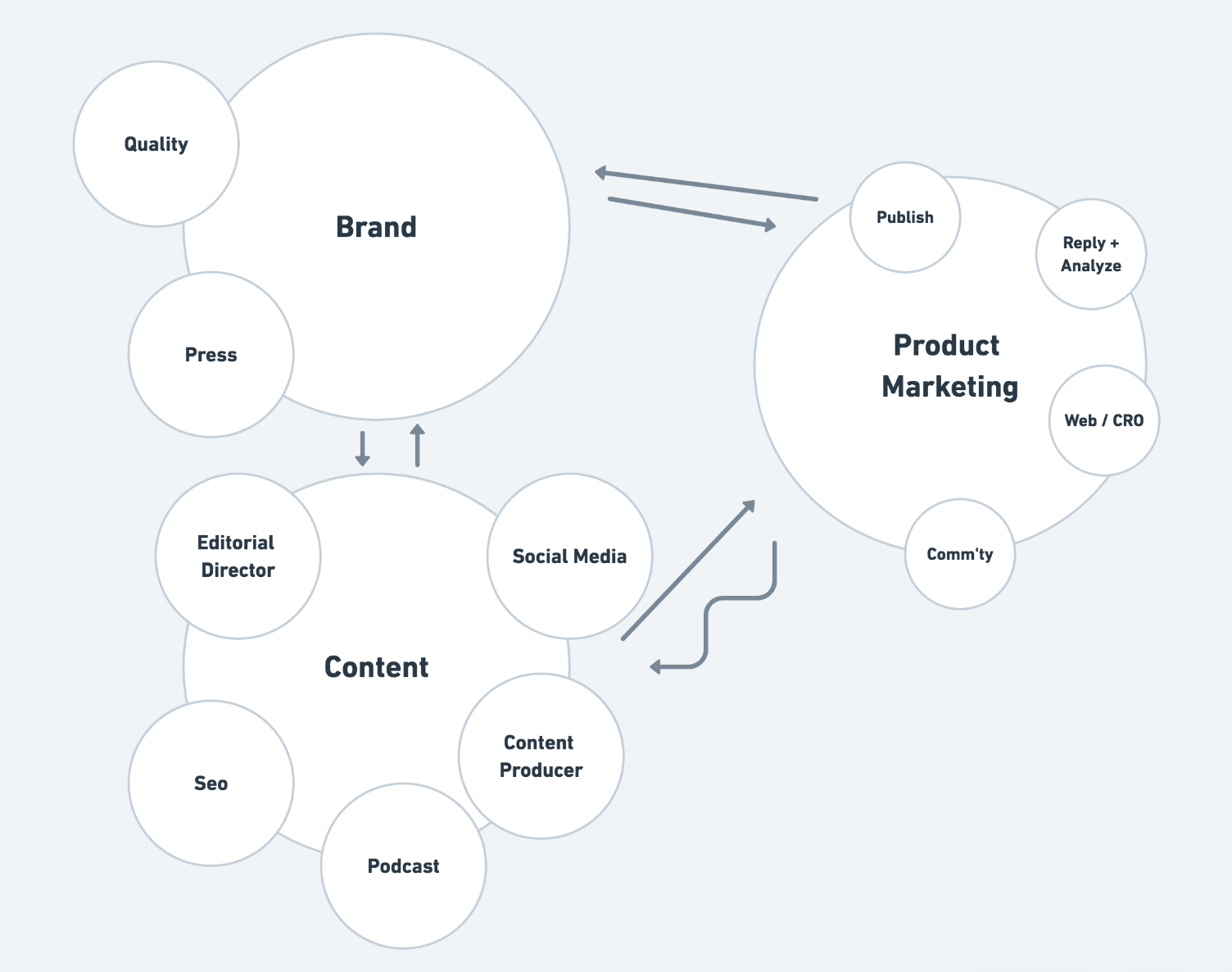
In addition to the dedicated product marketers, we also have a teammate who has deep skills with conversion, growth, and the marketing website. We’ve joined him with the product marketers to form a product marketing “circle.” He supports the product marketers with technical website changes, and he works on current projects and for overall growth goals for the product, pulling levers like CRO and pricing experiments.
Together, this “product marketing circle” works as a support group for one another and have a weekly call to discuss what’s happening and stay organized.
Future iterations of this model are likely to include:
- Aligning our community efforts closer to product (you might have noticed that Community is part of the product marketing circle in the above diagram)
- Bringing in a teammate to coordinate all product marketing and work with product leaders on the highest goals
6 Lessons We’ve Learned About Product Marketing at a Startup
1. Your product marketing will evolve as your team grows
In the startup world, it’s been said that you can expect your role to change every six months. And while that breakneck pace isn’t true for everyone, forever, we’ve found that an appetite for change is healthy when you’re approaching product marketing.
2. Product marketing is a team effort
Even today, we’ve retained some of the “all hands on deck” spirit of product marketing. We have our customer advocacy team helping out with lifecycle emails. We have our product engineers and designers assisting with website tasks. It takes a village!
3. Product marketing is both external and internal
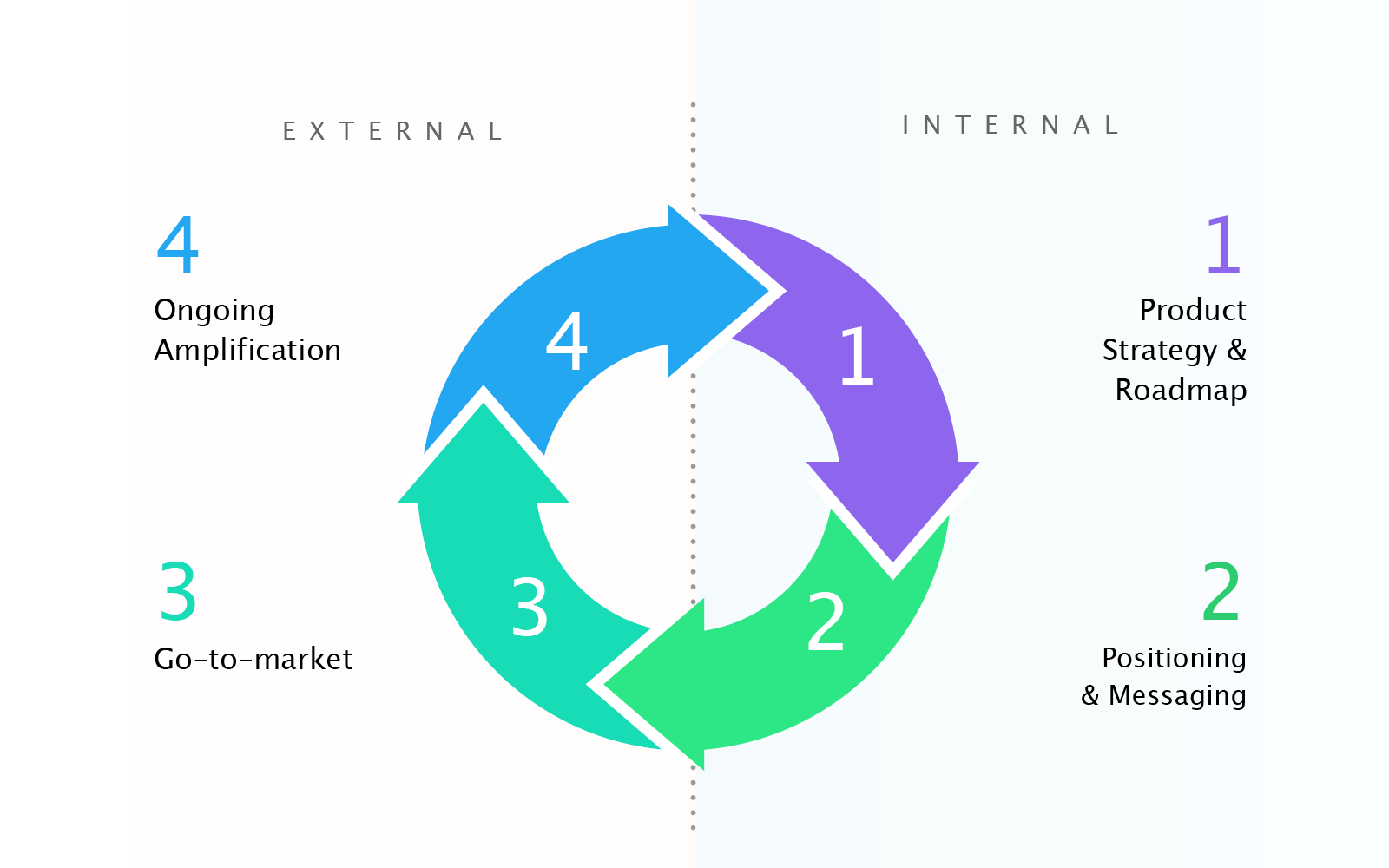
This diagram shows an example of how the role of a product marketer not only touches customers and your audience but also needs to serve the company itself. Our product marketers can influence company strategy with roadmap discussions and create momentum by sharing about product progress with the team.
4. We all “do” product marketing
Every role on our marketing team is focused on bringing attention and recognition to the problems we’re trying to solve for our customers. We are all focused on delivering value to customers. So, in a sense, we’re all doing product marketing, right?
5. The earlier, the better, when it comes to marketing and product conversations
One mistake we’ve made along the way is not including our marketing team earlier in product discussions. We’ve missed out on the perspective, positioning, and go-to-market expertise of these wonderful folks. Now, we feel we’ve remedied this by having the product marketers fully dedicated and in step with each product team.
6. There is no One True Way that a product marketing team should look
We’ve learned a lot of lessons from Intercom’s take on marketing. Here’s a sample from their book, Intercom on Marketing:

Further, they split their product marketing team into four core responsibilities:
- Reach: Get our messaging in front of the right audience
- Attract: Get that audience to visit our site and become leads
- Convert: Persuade leads to sign up and become customers
- Educate: Help customers get increasing value from and love our product
We found that this exact definition didn’t fit squarely with the way our company works. We don’t have a sales team, for starters. And the four core responsibilities they list here are split among different teams: for example, “Educate” often falls to our customer engagement team.
Over to you
What does product marketing look like at your company?
Do you have any advice for us with how we’re evolving?
Thanks so much for giving this article a read. I’d love to learn from you if you want to leave a comment here or talk with us on Twitter or Instagram.
Try Buffer for free
190,000+ creators, small businesses, and marketers use Buffer to grow their audiences every month.




